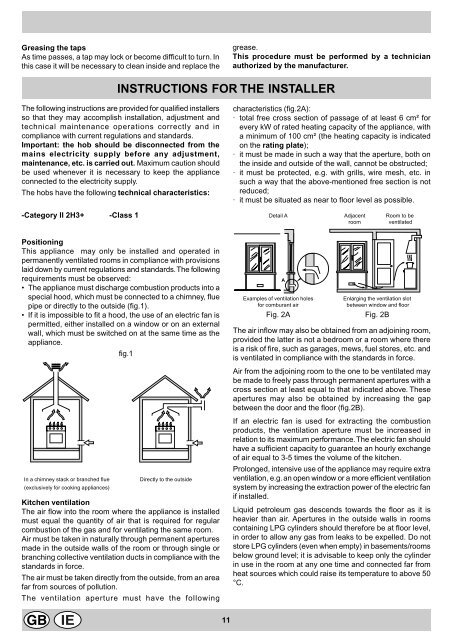KitchenAid XBP 40TC SX 2V FB - Hob - XBP 40TC SX 2V FB - Hob EN (F030359) Istruzioni per l'Uso
KitchenAid XBP 40TC SX 2V FB - Hob - XBP 40TC SX 2V FB - Hob EN (F030359) Istruzioni per l'Uso
KitchenAid XBP 40TC SX 2V FB - Hob - XBP 40TC SX 2V FB - Hob EN (F030359) Istruzioni per l'Uso
Create successful ePaper yourself
Turn your PDF publications into a flip-book with our unique Google optimized e-Paper software.
Greasing the taps<br />
As time passes, a tap may lock or become difficult to turn. In<br />
this case it will be necessary to clean inside and replace the<br />
grease.<br />
This procedure must be <strong>per</strong>formed by a technician<br />
authorized by the manufacturer.<br />
INSTRUCTIONS FOR THE INSTALLER<br />
The following instructions are provided for qualified installers<br />
so that they may accomplish installation, adjustment and<br />
technical maintenance o<strong>per</strong>ations correctly and in<br />
compliance with current regulations and standards.<br />
Important: the hob should be disconnected from the<br />
mains electricity supply before any adjustment,<br />
maintenance, etc. is carried out. Maximum caution should<br />
be used whenever it is necessary to keep the appliance<br />
connected to the electricity supply.<br />
The hobs have the following technical characteristics:<br />
-Category II 2H3+ -Class 1<br />
characteristics (fig.2A):<br />
· total free cross section of passage of at least 6 cm² for<br />
every kW of rated heating capacity of the appliance, with<br />
a minimum of 100 cm² (the heating capacity is indicated<br />
on the rating plate);<br />
· it must be made in such a way that the a<strong>per</strong>ture, both on<br />
the inside and outside of the wall, cannot be obstructed;<br />
· it must be protected, e.g. with grills, wire mesh, etc. in<br />
such a way that the above-mentioned free section is not<br />
reduced;<br />
· it must be situated as near to floor level as possible.<br />
Detail A Adjacent Room to be<br />
room ventilated<br />
Positioning<br />
This appliance may only be installed and o<strong>per</strong>ated in<br />
<strong>per</strong>manently ventilated rooms in compliance with provisions<br />
laid down by current regulations and standards. The following<br />
requirements must be observed:<br />
• The appliance must discharge combustion products into a<br />
special hood, which must be connected to a chimney, flue<br />
pipe or directly to the outside (fig.1).<br />
• If it is impossible to fit a hood, the use of an electric fan is<br />
<strong>per</strong>mitted, either installed on a window or on an external<br />
wall, which must be switched on at the same time as the<br />
appliance.<br />
fig.1<br />
In a chimney stack or branched flue<br />
(exclusively for cooking appliances)<br />
Directly to the outside<br />
Kitchen ventilation<br />
The air flow into the room where the appliance is installed<br />
must equal the quantity of air that is required for regular<br />
combustion of the gas and for ventilating the same room.<br />
Air must be taken in naturally through <strong>per</strong>manent a<strong>per</strong>tures<br />
made in the outside walls of the room or through single or<br />
branching collective ventilation ducts in compliance with the<br />
standards in force.<br />
The air must be taken directly from the outside, from an area<br />
far from sources of pollution.<br />
The ventilation a<strong>per</strong>ture must have the following<br />
Examples of ventilation holes<br />
A<br />
Enlarging the ventilation slot<br />
for comburant air between window and floor<br />
Fig. 2A<br />
Fig. 2B<br />
The air inflow may also be obtained from an adjoining room,<br />
provided the latter is not a bedroom or a room where there<br />
is a risk of fire, such as garages, mews, fuel stores, etc. and<br />
is ventilated in compliance with the standards in force.<br />
Air from the adjoining room to the one to be ventilated may<br />
be made to freely pass through <strong>per</strong>manent a<strong>per</strong>tures with a<br />
cross section at least equal to that indicated above. These<br />
a<strong>per</strong>tures may also be obtained by increasing the gap<br />
between the door and the floor (fig.2B).<br />
If an electric fan is used for extracting the combustion<br />
products, the ventilation a<strong>per</strong>ture must be increased in<br />
relation to its maximum <strong>per</strong>formance. The electric fan should<br />
have a sufficient capacity to guarantee an hourly exchange<br />
of air equal to 3-5 times the volume of the kitchen.<br />
Prolonged, intensive use of the appliance may require extra<br />
ventilation, e.g. an open window or a more efficient ventilation<br />
system by increasing the extraction power of the electric fan<br />
if installed.<br />
Liquid petroleum gas descends towards the floor as it is<br />
heavier than air. A<strong>per</strong>tures in the outside walls in rooms<br />
containing LPG cylinders should therefore be at floor level,<br />
in order to allow any gas from leaks to be expelled. Do not<br />
store LPG cylinders (even when empty) in basements/rooms<br />
below ground level; it is advisable to keep only the cylinder<br />
in use in the room at any one time and connected far from<br />
heat sources which could raise its tem<strong>per</strong>ature to above 50<br />
°C.<br />
11
















